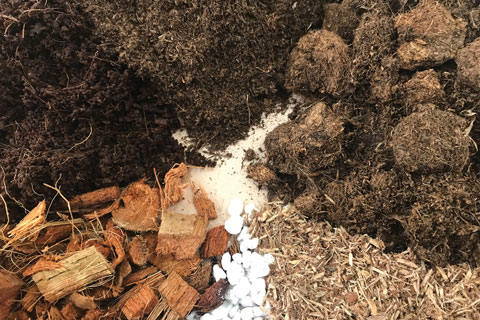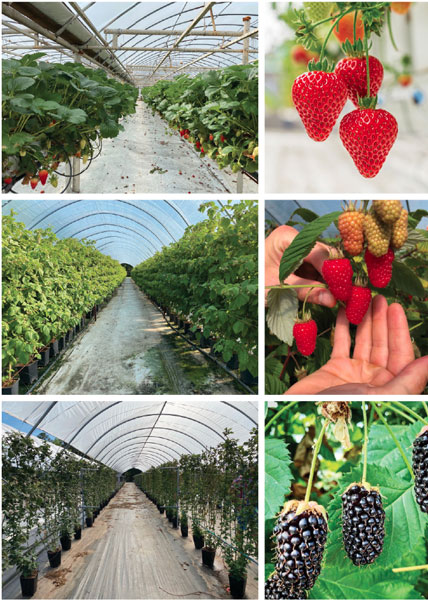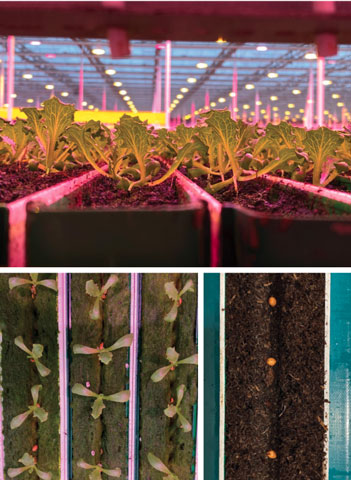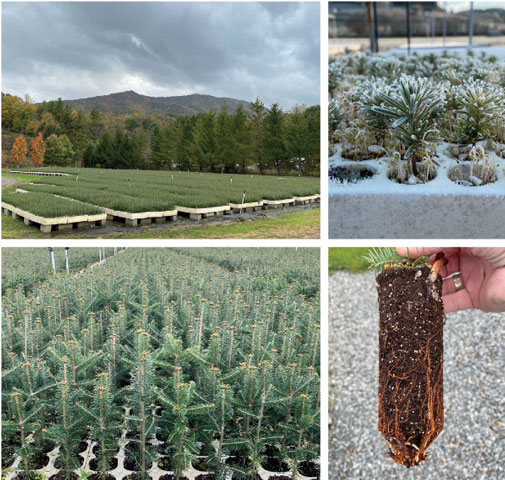4/1/2022
Soilless Substrate Science for Current & Future Growers
Brian Jackson, Jeb Fields, Jim Owen & James Altland

Many horticultural crops spend a portion of their life-cycle in soilless substrates/systems. Soilless culture provides an easy-to-manage, more forgiving, precision-driven and interchangeable system for production of ornamentals, vegetables, leafy greens, herbs, small fruit, cannabis and other emerging crops within conventional systems, especially in areas where soil is depleted and water is limited.
Figure 1: Both organic and inorganic soilless substrate components remain in extraordinary high demand as global usage is at unprecedented levels.
Currently, there’s a strong reliance on industrial or forestry/agricultural byproducts and sphagnum peat that are blended together to meet antiquated physical and chemical property standards that can “do-no-harm” when producing relatively short-term crops (Figure 1).
Soilless substrates must be “engineered” to provide solutions for short- and long-term crops, spanning weeks to a decade, while ensuring resources—including substrate components, water and agrochemicals—are used wisely. The solution is with partnered allied suppliers, end users or growers, and scientists to identify the opportunities and challenges for today and the next 20 years to meet the increasing global demand for soilless substrates that’s predicted to more than double.
Where soilless is shifting
One step towards our collective goal of identifying areas of opportunity, assessing grower needs and supporting the efforts of growers who want to transition to soilless production was completed in 2020-2021 with a national survey of specialty crop growers in North America. This needs assessment was critical for our research team’s efforts to identify and better understand the challenges of growers who currently use soilless substrates, and identify the concerns and needed support for growers who are interested in transitioning some part (or all) of their production to soilless systems.
 Figure 2: The transition of many fruit crops to soilless cultivation is helping to drive the demand for substrates.
Figure 2: The transition of many fruit crops to soilless cultivation is helping to drive the demand for substrates.
One of the largest horticultural sectors identified that’s transitioning large acreage to soilless production is the small fruit industry. The cultivation of small fruit to soilless production isn’t “new,” but the rate at which many growers in certain parts of the country are transitioning is unlike any shift in production practices seen in the past.
Growth of berry crops in container systems has been prevalent in Europe for many years, but interest in expanding production continues to increase. South America (namely Peru) and Mexico are converting berry crops to soilless production at probably the fastest rate (and volume) in the world. It seems that blueberry production is “leading the way” with converted acreage, but other crops aren’t far behind. Soilless cultivation of strawberries, blackberries and raspberries is seeing increased interest and market share (compared to field grown) at many locations around the U.S. (Figure 2).
Other fruit crops that we’ve seen, or that have been reported in the literature and on company websites, include figs, avocados, citrus, bananas and cherries. Industry and public (academic and USDA) research and on-site grower trials of these fruit crops are currently establishing optimal growing conditions and cultural practices, including substrate selection, container type/design, irrigation management, fertility type and delivery, effects on fruit flavor profiles (compared to soil-grown fruit), postharvest quality, and shelf life, among others.
The expansion of controlled environment food production (namely leafy greens, tomatoes, herbs and strawberries) has helped place a public spotlight on the importance and scale of modern agriculture in the 21st century. These production systems, like those mentioned for fruit crops, are reliant on novel soilless substrates. Traditional substrate materials like rockwool and peat are heavily used in controlled environment agriculture (CEA; Figure 3), but many growers are interested in—or demanding—new and alternative substrate products that don’t come from a sole-source supplier, shipped from overseas, but are more sustainable or are produced closer to their production facility. In many ways, substrate consumers or customers are driving new product development and shifts in crop production practices more than ever before.
 Figure 3: Increased plant production in vertical farms and other controlled environment systems is also reliant on soilless substrates.
Figure 3: Increased plant production in vertical farms and other controlled environment systems is also reliant on soilless substrates.
One additional example of a major specialty crop that’s shifting production to soilless growing is the Christmas tree industry. Many tree species are grown and sold across the country as Christmas trees, but Fraser fir remains the dominant and preferred tree of choice. For reasons similar to many fruit crops, the increased soil disease pressure (Phytophthora) and shortened seedling production times has created interest among tree growers to produce seedlings in container systems (Figure 4). Some research is ongoing, and much more is needed to support this industry and allow more growers to transition to soilless seedling production if and when they choose.
Ramping up research efforts
Currently, across the emerging specialty crop production world, it seems that the majority of information, cultural practices, evidence of crop/yield success, and most other needed information and tools are being discovered or “figured out” by growers themselves with little assistance from scientists to support them (though there are some—just not enough!). Many growers are being assisted in their efforts (grow trials) by R&D and technical specialists at the various substrate suppliers from whom they purchase products, but limited research from the “traditional” sources of USDA and academia has been focused on this evolving sector of horticulture production.
 Figure 4: Traditionally field-grown specialty crops like Christmas trees are increasingly being grown in container systems using soilless substrates.
Figure 4: Traditionally field-grown specialty crops like Christmas trees are increasingly being grown in container systems using soilless substrates.
Our collective efforts to support the existing and new specialty crop producers in North America should:
1. Acknowledge the emerging shift of specialty crop production to soilless systems
2. Accept that this shift isn’t a temporary trend, but a fixture in the future of crop production
3. Understand how rapidly soilless cultivation is expanding
4. Predict short- and long-term growth potential and its impact
5. Identify the barriers to entry preventing more expansion into soilless culture
6. Be strategic in how science-based research from publicly funded institutions can be better aligned with current and future industry needs
7. Provide easily accessible research data, crop production guidelines, diagnostic tools, research updates and other critically important resources to growers whenever they need it
It’s our hope that these steps, among others, will create more opportunities than challenges for growers in the future. GT
Brian Jackson is a Professor of Substrate Science and Director of the Horticultural Substrates Laboratory at North Carolina State University. Brian can be reached at Brian_Jackson@ncsu.edu. Jeb Fields is an Assistant Professor and Research Coordinator at the Hammond Research Station at Louisiana State University. Jim Owen is a Research Horticulturist and James Altland is a Research Leader, both at the USDA-ARS Application Technology Research Unity in Wooster, Ohio.